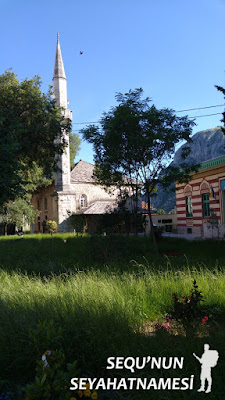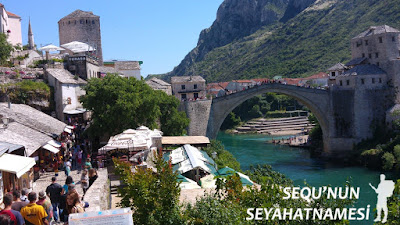As a Turkish person, I think the place outside our lands that makes us touched most is Mostar due to our cultural ties. It was a really different feeling to cross the historical bridge and walk around the city.
In this article, I'll tell my experiences on transportation, money exchange, left luggage, baggage fees, border crossings, accommodation, local language, what to eat & drink and places to visit in Mostar.
First of all, I would like to say something short about its historical background.
- HISTORICAL BACKGROUND
Mostar became a part of Ottomans in 15th century. The famous 17th century Turkish traveller Evliya Çelebi says that the word of "Mostar" means "city of bridge" in Latin. Like other Balkan languages, the word of "Most" means "bridge" in Bosnian. In this case, Mostar would mean "bridge keeper" or something like that.
Before I left home for the Balkans, I had read Evliya Çelebi's travel book "Seyahatname" which is more than 4000 pages. He says that he had seen many bridges until that time but he had never seen a bridge higher than Mostar Bridge and no other bridges had no architecture, art and sweetness like Mostar Bridge had.
- TRANSPORTATION
As I mentioned in my Kotor article, I couldn't find any information about going to Mostar from Kotor directly. A friend of mine reminded me there was one just after I returned home. This bus departs at 10 pm from Kotor and the journey takes about 8 hours. Also, it doesn't go via Croatia. This is a good news for those who has no Schengen Visa. The company for this time is Jadran Express and one way ticket is 37 Euros.
Apart from that, it is necessary to go first to Herceg Novi or Podgorica from Kotor to get to Mostar. This option would have meant spending much more money and maybe mostly being in a hurry early in the morning. Instead, I had the Kotor Old Town Hostel's transfer vehicle arranged for 30 Euros and it took me just 4 hours.
On the other hand, if you would like to go to Sarajevo from Mostar, note that the last bus from Mostar Bus Terminal departs at 6:15 pm. You will find out more details in my Sarajevo article. Apart from this, there is also the train option from which you can take great photographs on its route. As far as I know, it departs at 6:57 pm. However, trains have currently been suspended due to the refugee question.
- MONEY EXCHANGE
The currency unit in Bosnia is Konvertibilna Marka or KM shortly. The exchange rate is fixed so 1 Euro equals 1,95 KM. However, this may change due to the place you are at. For instance, the woman who I got my bus ticket from calculated at 1,90 while the reception of my hostel took it at 1,85.
At the bus station, I did not get to see any change office. I asked a local and he showed Autoprevoz bus company where you will buy your ticket to Sarajevo. I had got only Euros so I paid in Euros for the ticket and the woman gave me KM for the rest.
- LEFT LUGGAGE
You could leave your bags to the woman who works at Autoprevoz Bus Company. She charged me 2 Euros per item and labelled it.
- BAGGAGE FEES
Baggage fees are irritatingly applied in Bosnia as well. The driver of Mostar-Sarajevo bus charged me 1 KM for my bag.
- BORDER CROSSINGS
We set out from Kotor at 8:30 am and arrived at Bosnian border at 10:05 am. We totally waited for just 10 minutes on both sides. The border crossing was hassle-free and no questions were asked. My passport got stamped as Vraćenovići from Montenegrin side and Deleuša from Bosnian side.
- ACCOMMODATION
Since I made a daytrip to Mostar, I didn't need to stay there. I believe that you can easily finish the city in just 3-4 hours or so.
- PLACES TO VISIT IN MOSTAR
Mostar Bridge : It is the number one activity and symbol of the city. The construction started in 1557 in Ottoman Sultan Suleyman the Magnificent and finished in 9 years. The architect of this bridge was Architect Hayreddin who was the scholar of famous Architect Sinan.
In 15th century, there was a chain bridge here and then a new wooden bridge was built. After that, Mostar Bridge was constructed instead of the wooden bridge. The Mostar Bridge was destroyed by Croatian bombarding in 1993.
Mostar Bridge means Stari Most in Bosnian language. As Evliya Çelebi says young boys used to jump onto Neretva River from Mostar Bridge to be able to get a tip from the viziers. Although, it has been 500 years, this tradition is still going on. You can see a few people who ask money from tourists to jump.
There are two towers on the both sides of the bridge. The one on the right according to the picture I posted above is Tara Tower and the one on the left is Halebija Tower. These two war towers were built to defend the Mostar Bridge. Towers used to have any kind of ammunition. Both towers also used to have very strong iron gates. These iron gates were missed to Austria during Austria-Hungary Empire occupation in Bosnia.
It is allowed to go up to the Tara Tower. As far as I remember, it was a 4 or 5 storey tower. The tower has Ottoman inscriptions, old war equipments, information board about phases of the bridge and firman of the Sultan to finish the bridge. The entrance fee was 2 KM, but nobody asked me any money. The officer woman told me that the tower would be closed at 3 pm. In this video, I'm at the top floor of the tower.
When it comes to Halebija Tower, I didn't go inside. It looked like a two storey building and there is a souvenir shop and exhibition photos of 1993 war.
Lastly, Mostar Bridge was renovated in 1996 due to the attempts of Turkey by sending 1 million USD to the World Bank. Apart from Turkey, Holland, Italy, Croatia, European Participation Bank and World Bank.
Bridge Museum : It is just below the Tara Tower and looks like an archeology museum. It contains original pieces of the Mostar bridge which was destroyed by Croatians, some photographs about works for the bridge and some other visual materials.
Nasuh Aga Vućijakovic Mosque : It will probably the first bridge you will see when you come from the bus terminal. This mosque was built in Sultan Suleyman the Magnificent in 16th Century.
Karagoz Begova Mosque : It was built in 1557 and is one of the most significant mosques in Mostar. The entrance fee is 5 KM.
Koski Mehmed Pasha Mosque : It was built in 16th century and is located near the shore of Neretva River. The entrance fee is 5 KM. It is really frustrating for me to see that an admission cost is charged for the mosques in Bosnia. For example, there is absolutely no fee for any mosque in Turkey.
There is a sweet ablution fountain in the middle of the courtyard. This water is drinkable. There are also some shops who sell clothes. I think this place was used as a madrasa.
Ćejvan-Ćehaja's Mosque : This mosque was built in 1552 and is the oldest one in Mostar.
Roznamedzi Ibrahim Efendije Mosque: Rozname was like a notebook or something like a diary in Ottomans and this Ibrahim Efendije was the Roznamedzi of Sultan Murad IV in the 17th century. He was the first person who supplied water to Mostar.
Tabacica Mosque :It is located near Tourist Info and Cejvan Bey Hammam. You could reach there turning right when you pass the Mostar Bridge. This mosque was built in 16th century and the entrance fee is 5 KM.
Ceyvan Bey Hammam : This hammam is located very close to the Tabacica Mosque and is used as a museum today.
Crooked Bridge : Its name is Kriva Cuprija in Bosnian language. This bridge was built just about 100 meters behind where Radobolja and Neretva Rivers meet. Although it is said that this bridge was built in 1558, it is probably much older than this according to the historical sources I have read.
Bišćevića House : It's an original Turkish house that was built in 1635 and is well-preserved building. The owner of the shop that is located just before the entrance of this house, gives some information about this house.
Kujundžiluk Bazaar : It is an enjoyable street to stroll around. You can find lots of different kind of souvenirs.
Muslim Begova House : As far as I know, this places is both used as a hostel and a museum. The entrance fee is 4 KM.
Herzegovina Museum : It's a small museum which houses some photo collections about Mostar. It was closed by the time I got there since they run until 2 pm.
- BOSNIAN LANGUAGE
Bosnian language is really close to other languages spoken in the Balkans. Since it's a touristy city, you will see English and Turkish spoken in the center and around the bridge. However, I heard some people who were speaking Italian near the bus terminal.
- WHAT TO EAT & DRINK
Since I have been to Mostar for a day and didn't want to lose time at a restaurant, I preferred to have some snacks like burek. I went into the first Pekara (pastry shop in Bosnian) when I was coming from the bus terminal. I paid 3,20 KM for a Bosnian burek plus fruit juice.
In the center, around the Old Bridge, there are plenty of ice-cream sellers. They charge 0,5 Euro or 1 KM for one ball.
There are also lots of restaurants and cafes around the Old Bridge. You could also try them.
In my next article, I will share my experiences in Sarajevo.
.png)
 By
By  October 26, 2016
October 26, 2016












0 comments